Learn How to Play Sequence Card Game
Welcome to our turn-based card-matching game online platform, where 2 players can match cards in their hands with the cards on the game table. The game is played with a standard 52-card deck, which includes 4 suits (♤♡♧♢) and 13 cards per suit. Additionally, there are 4 jokers that can be randomly allocated special powers. Two jokers can eliminate the opponent's cards, while the other can be used as any card on the table..
A Detailed Guide on How to Play Sequence Card Game

This guide will provide you with a comprehensive understanding of the rules and tactics involved in playing the classic sequence card game, empowering you to play with assurance and expertise. The objective of the game is to be the first player to create two sequences of three cards in any direction on the game table. A sequence is formed when three chips are placed adjacent to each other in a straight line, either horizontally, vertically, or diagonally.
1. Components
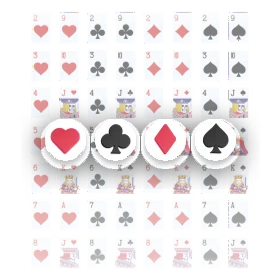
Deck
A standard deck of 52 cards, consisting of four suits (♤♡♧♢) and thirteen cards (Ace to 10, Queen, King) in each suit. Additionally, there are four Jokers (J♤ J♡ J♧ J♢) with special powers.

Chips
There are 52 chips, with 26 chips of one colour for each player. These chips are used to mark the cards on the game table.
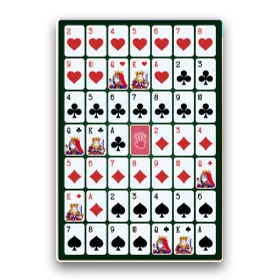
Game Board
A 7x7 game board that represents the table. This board will hold the cards during gameplay.
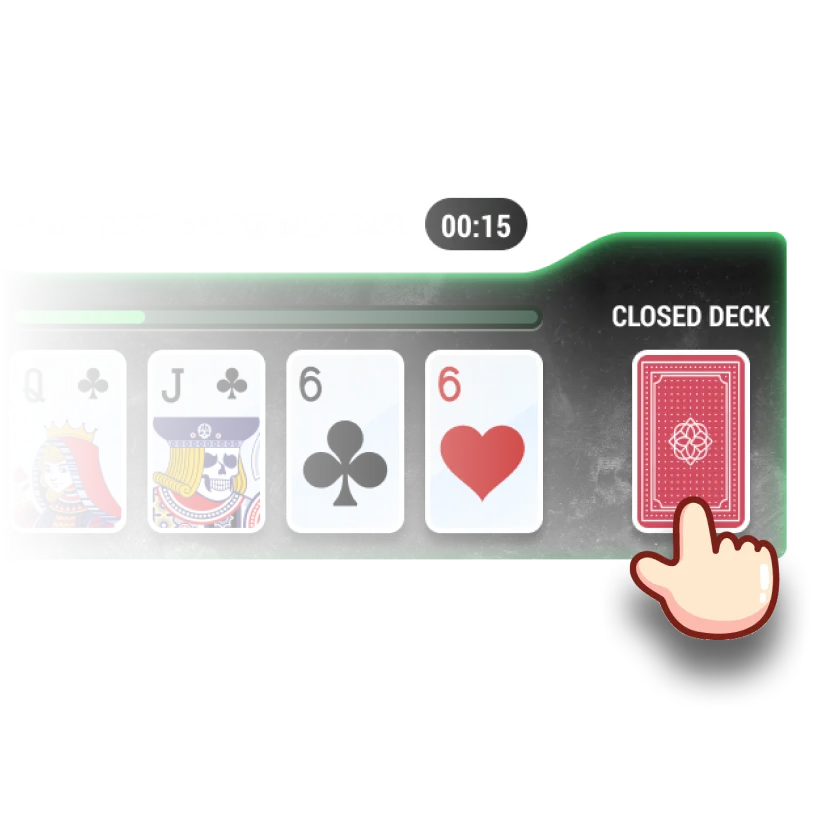
Closed Deck
The closed deck contains the remaining cards not distributed to the players. It is used for drawing cards during the game.
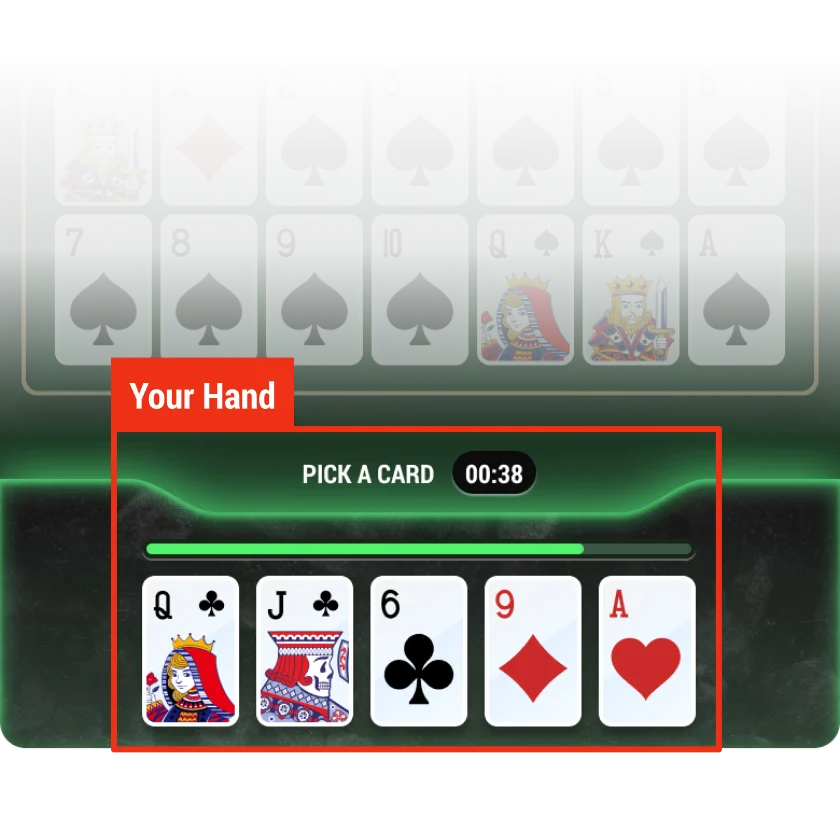
Hand
Each player starts with a hand of five cards. The players can see their own cards but not their opponents.
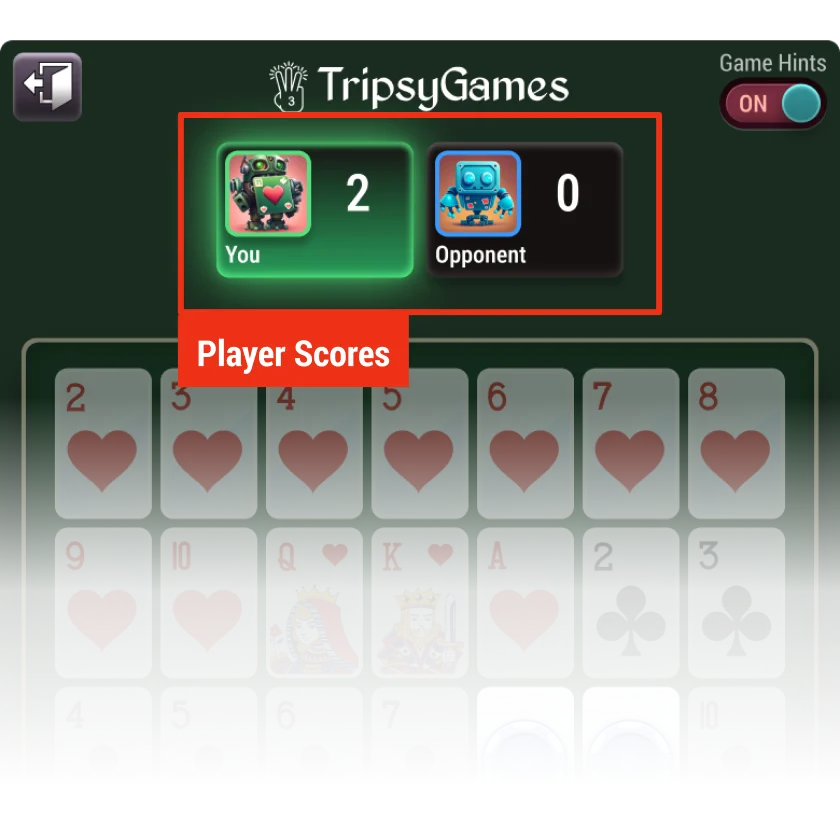
Players
The game is played between 2 players. Each player should be above 21 years of age to play cash games. Any player can play free-to-play games.
2. Game Setup

Players
The game is played between 2 players. Each player should be above 21 years of age to play cash games. Any player can play free-to-play games.
Distribution
Randomly distribute five cards to each player from the deck. The remaining cards form the closed deck.
Game Board
Place the 48 randomly selected cards from the deck on the 7x7 game board. The central card is a trump card that any player can use.
Valid Moves
On your turn, select one card from your hand and place it on the game board by matching it with the corresponding card on the table. The card must be placed in a valid position to form a sequence. In Tripsy Games, the sequence of numbers can be random. The goal is to strategically place three chips next to each other either horizontally, vertically, or diagonally before your opponent does.
Valid Sequences
A sequence is considered valid if there are three chips adjacent to each other either horizontally, vertically, or diagonally.
Trump Card
The central card on the game board is a trump card that both players can use. However, once a sequence is formed using the trump card, it can't be used again. To gain an advantage over your opponent, try placing your chips next to the trump card before they do. This can be accomplished by placing your chips vertically, horizontally, or diagonally adjacent to the trump card. Once you have done so, you can use the trump card as a connecting card to create a sequence. Remember, in Tripsy Games, there is no need to worry about whether the cards are of the same or different suits.
Drawing Cards
After placing a card on the board, draw a card from the closed deck to replenish your hand. If the closed deck is empty, continue playing with the cards in your hand.
Special Joker Powers

There are two types of Jokers in the deck with special powers

1 Eyed Joker
These Jokers can eliminate an opponent's card from the game board. However, they cannot remove a card in a pre-set sequence placed by either player.

2 Eyed Joker
These Jokers can be used as any green highlighted card on the table, from Ace to King. Once a 2 Eyed Joker is placed, it takes the form of the card that was supposed to be in that position.
Invalid Moves
If a player tries to place a card on the board that is not a legal move, the card is returned to their hand, and an additional card is drawn from the closed deck as a penalty.
Multiple Sequences
Players can work on multiple sequences simultaneously. Once a sequence is completed, the player can start a new sequence.
Blocking Opponents
To prevent opponents from forming sequences, players can strategically place their cards to block their opponents' paths. This adds a layer of strategy to the game.
Winning the Game
These Jokers can be used as any green highlighted card on the table, from Ace to King. Once a 2 Eyed Joker is placed, it takes the form of the card that was supposed to be in that position.
Optional Rules and Variations
Sequence card game allow for some optional rules and variations to add excitement and variety to the gameplay.
Basic Rules of the Game!

The game is a turn-based card-matching game where 2 players compete to make two sequences of 3 cards each. The game aims to be the first player to create two valid sequences.
Sequence Formation
The goal is to match the cards in your hand piles with the ones on the board to create three consecutive chips either horizontally, vertically, or diagonally. You do not have to keep track of the suits. The sequence does not necessarily have to be from the same suit. It can be any card. Your objective is to create a sequence of three chips that are adjacent to each other before your opponent does. It is not allowed to utilize or engage with the cards that your opponents have already played.

Game End
The game ends when a player successfully creates three sequences of 3 cards each. The sequences can be formed horizontally, vertically, or diagonally. Once a player achieves this, they are declared the winner of the game. If all the cards in the closed deck have been drawn and neither player has achieved the win condition, the game ends in a draw.

Winner Declaration
The player who successfully creates three sequences of 3 cards first is declared the winner. They are awarded the winning amount, calculated based on the players' entry fees and the platform service fee. The losing player receives no winnings.
Remember, the game also includes various rules for card play, using jokers, drawing cards, handling invalid moves, handling a game draw, and handling the end of a player's turn, among other aspects. These rules ensure fair gameplay and provide a smooth gaming experience for the players.
You can find the detailed rules for the Sequence game here.
Quick Tips to Win the Game!

Stay Ahead
To gain an advantage in the game, aim to create at least one sequence before your opponent does. Staying ahead of your opponent is key to success.
Practice Game
You can upskill yourself through practice games before participating in tournaments or cash games.
Understand the rules
Know how to create two sequences of 3 cards, each horizontally, vertically, or diagonally to win the game.
Pay attention to the table
Observe the cards on the table and plan your moves accordingly. Look for potential sequences and try to block your opponent from forming sequences.
Strategies your card placements
Consider using jokers. Utilise remover jokers to eliminate your opponent's cards strategically.
Time management
Each player has a limited time to make a move. Use your time wisely to analyse the table and make the best possible move. Don't rush, but also avoid unnecessary delays.
Plan ahead
Plan your moves in such a way that you can create two sequences before your opponent does.
Utilise the central trump card
The central trump card can be used by both players. Remember that the central trump card cannot be used again once a sequence is formed.
Keep track of the closed deck
Monitor the number of cards remaining in the closed deck. If the closed deck is running low, adjust your strategy accordingly.
Avoid invalid card placements
Invalid moves can waste your turn and give an advantage to your opponent. Double-check before making a move. Once your opponent uses a card, you cannot replace or play that card.
Want to learn some more tips and tricks to give you an edge in the game?
How Is the Winner Finalised & Winnings Calculated?

To finalise the winner and calculate the winnings in the card-matching game described, the following steps are followed:
Game End
The game ends when one player successfully creates two sequences of three cards, horizontally, vertically, or diagonally.
If all the cards in the closed deck have been drawn and neither player has achieved the win condition, the game ends in a draw.
Winner Declaration
The entry fees of the players determine the total pool of the game.
The platform service fee, typically a percentage of the total pool, is deducted from the total pool.
The remaining amount is the winning amount that will be awarded to the winner.
The loser does not receive any winnings.
Let's assume Players 1 and 2 play the game with an entry fee of Rs. 100 each, making the total pool Rs. 200. The platform service fee is 10% of the total pool, which amounts to Rs. 20. The winning amount for the winner is calculated as follows Winning amount = Total pool - Platform service fee Player 1 would receive Rs. 200 - Rs. 20 = Rs. 180 as the winning amount, while Player 2 would receive no winnings.
To provide an option for a rematch, both players can agree to start a new game by resetting the game board and the deck. However, the platform fee will still be deducted for every rematch.
Rematch Option
After the game ends, there can be an option for a rematch.
If both players agree to a rematch, the game board and deck are fully reset, and a new game is created for the players.
However, the platform fee will still be deducted for every rematch.
Contact Our Support

We at Tripsy Games are always available to help you! Our team is available 24/7 to answer any gameplay, game rules, or winnings questions. Please don't hesitate to reach us anytime, and we will be delighted to assist you.
Frequently Asked Questions

1) What is the Sequence game, and how do I play it?
The game's objective is to be the first player or team to complete a sequence of three chips in a row on the game board. A sequence can be formed horizontally, vertically, or diagonally. For more details you can visit our Sequence game rules and Sequence game tips & tricks
To play Sequence, you will need a game board, two standard decks of playing cards (excluding the jokers), and a set of coloured chips for each player or team. Each player or team takes turns placing chips on the corresponding cards on the board, trying to create sequences.
2) What is the number of players permitted to play Sequence?
The Sequence can be played with a minimum of 2 players
3) Are there any unique strategies or tactics I should remember while playing?
Focus on blocking your opponents
Place your chips strategically to block your opponents' sequences and disrupt their plans.
Create multiple sequences simultaneously
Instead of focusing on just one sequence, create multiple sequences simultaneously to increase your chances of winning.
Use the special cards wisely
The game includes special cards such as Jacks, which allow you to remove an opponent's chip or place your chip on any open space. Use these cards strategically to gain an advantage.
Pay attention to the board
Keep track of which cards have been played and which are still available. This will help you plan your moves and anticipate your opponents' strategies.
4) What is the goal of the Sequence game?
The goal of the Sequence game is to be the first player to complete a sequence of three chips in a row on the game board. The sequence can be formed horizontally, vertically, or diagonally. The first player or team to achieve this goal wins the game.
5) Is there a specific sequence I must create to win the game?
There is no specific sequence that you must create to win the game. You will achieve a sequence and win the game if you have five of your chips in a row, either horizontally, vertically, or diagonally. The sequence can be formed using any combination of cards on the game board.
6) How do I play a card in Sequence?
To play a card in Sequence, you must place one of your coloured chips on the corresponding card on the game board. Each card on the board corresponds to a specific playing card in the deck (except the Jacks). For example, if you have a 7 of diamonds in your hand, you would place your chip on the 7 of diamonds on the game board.
Please let me know if you have any further questions!